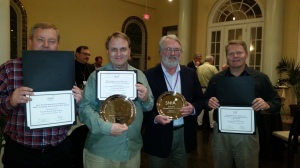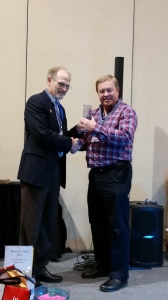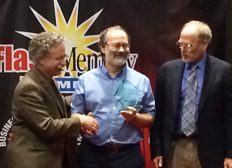Note: This blog entry is authored by SNIA Solid State Storage Initiative Governing Board member Gilda Foss, who serves on the SNIA Solid State Storage Initiative [SSSI] Governing Board as well as her role as Industry Evangelist in the CTO Office at NetApp, Inc.
Solid state drives use semiconductor chips, as opposed to magnetic media, to store data. The chips that solid state drives use are non-volatile memory meaning that the data remains even when the system has no power. I’ve written about solid state drive technology in the past and I will continue to, for it represents the first major advancement in primary storage in a very long time. Serving on the Governing Board of the SNIA Solid State Storage Initiative, it allows me to help foster the growth and success of the market for solid state storage in both enterprise and client environments. Our goals are to be the recognized authority for storage made from solid state devices, to determine and document the characteristics of storage made from solid state devices, and to determine and document the impact of storage made from solid state devices on system architectures.
So what can you expect if you were to ever upgrade to an SSD? Well, for starters your computing experience will be transformed with screaming fast random access speeds, multi-tasking proficiency, as well as fantastic reliability and durability… and you can choose between an external SSD or even a hybrid drive so you’ve got some options. A new SSD will make your system faster because the boot times will decrease, launching apps will be lightening fast, opening and saving docs will no longer drag, copying and duplicating file speeds will improve, and overall your system will have a new ‘pep in its step’. Furthermore, to promote being green, SSDs consume far less power than traditional hard drives, which means they also preserve battery life and stay cooler. Who doesn’t want and need that? They’re also very quiet, with none of the spinning and clanking you get with HDDs – for obvious reasons. SSDs are cooler and quieter, all the while being faster.
Since modern SSDs are Flash-based, there is no real hard-defined difference between Flash and SSD. Rather, as mentioned previously, Solid State Disk is essentially storage that doesn’t require moving parts and Flash is what allows that to exist. SSDs use Flash instead of RAM these days, since it’s a type of memory that’s super fast and doesn’t require continuous power, making it non-volatile. A match made in solid-state heaven.
There are some fundamental aspects that folks expect from a robust flash-based storage solution. First off, I/O performance and efficiency for many applications, including database acceleration, server and desktop virtualization, and cloud infrastructure. You should also expect to speed up overall IT performance, boost responsiveness of performance-critical applications, and reduce power costs and over-provisioning. Furthermore, you will obviously use more high-capacity, low-cost SATA drives while improving utilization of your data center space. If you can achieve all your flash-based goals without changing your IT infrastructure management processes, then you’ve really got it good.
Flash storage has customarily had substantial aging issues. In a nutshell, a user could only write to the memory a certain number of times before they would just lose that section of the drive coupled with the fact that performance would degrade over time, too. However, a lot of these issues were resolved and companies started manufacturing SSDs out of Flash memory instead of out of RAM.
I’ve stated in the past that many people in the industry believe that flash SSDs will eventually replace traditional hard drives. By the time this happens other characteristics, such as slower write time and added cost, will likely have been eradicated or significantly diminished. Even today, an SSD can extend the life of a laptop battery, reduce the weight of the system, make it quieter, and increase read performance. When properly and optimally engineered, SSDs are now at least as reliable as traditional spinning hard drives. Relating to the faster speed, think of one starting up in seconds versus minutes. Even the slowest current SSD gives you much improved real-world performance than does the fastest conventional hard drive, perhaps even 100x as fast. This allows for better user productivity, allowing for more work to get done in a fraction of the time. Furthermore, using flash in enterprise storage servers means you can support more users, do more work, and use less power so it’s no wonder that it’s become an important technology for business transactions. It’s a solid win-win-win.
SSSI’s 2014 Mission
This SNIA initiative was formed in September 2008 and its mission is to foster the growth and success of the market for solid state storage in both enterprise and client environments. Our goals are to be the recognized authority for storage made from solid state devices, to determine and document the characteristics of storage made from solid state devices, and to determine and document the impact of storage made from solid state devices on system architectures. Additionally, the SSSI collects solid state technical requirements of storage system vendors and communicate to SSD manufacturers for common features, behavior, and robustness. The initiative collaborates with academia and the research labs of member companies to understand how advances in solid state memory will impact storage made from solid state memory as well as to educate the vendor and user communities about storage made from solid state devices.
The SNIA SSSI also coordinates education activities with the Education Committee, performs benchmark testing to highlight the performance advantages of solid state storage, create peer reviewed vendor neutral SNIA Tutorials, and create vendor-neutral demonstrations. The SSI also leverages SNIA and partner conferences, collaborate with industry analysts, perform market outreach that highlights the virtues of storage made from solid state devices. The initiative determines what technical work should be performed within SNIA technical working groups to further the acceptance of storage made from solid state devices. Furthermore and very importantly, the SSSI determines the standards that will be necessary to support the industry usage of SSDs by performing interoperability plug-fests as necessary in support of standards development.
Collaboration between other SNIA organizations is also key. The SSSI works with the Storage Management Initiative (SMI) to understand how SMI-S can be used to manage storage made from solid state devices. We also work with the Green Storage Initiative (GSI) to understand how storage made from solid state devices will impact energy use in computer systems. The work that the SSI does with the Technical Council helps create the desired technical working groups and provides external advocacy and support of these technical working groups.
Finally, the SSSI collaborates with other industry associations via SNIA’s Strategic Alliances Committee (SAC) on SSD-related technical work in which they are involved as well as coordinates with SNIA Regional Affiliates to ensure that the impact of the SSS Initiative is felt worldwide. For more information, please visit http://www.snia.org/forums/sssi



